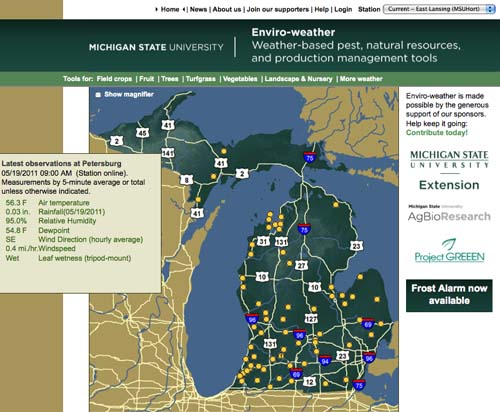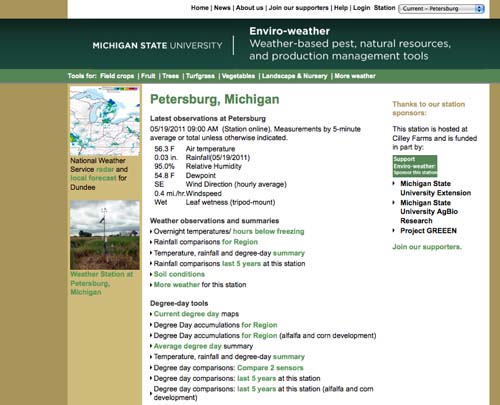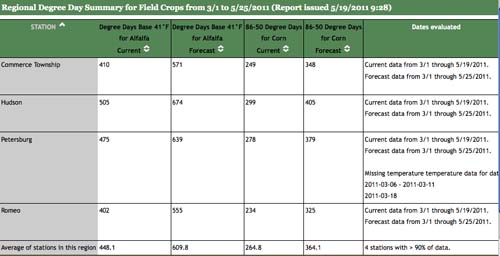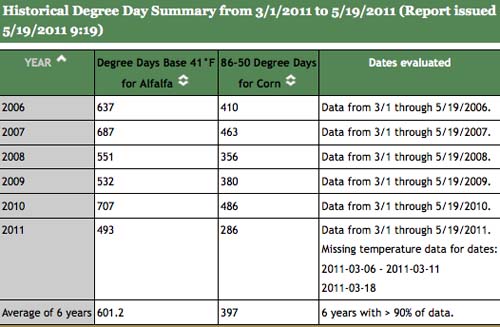New degree-day summary tools for field crops now available on Enviro-weather
New Enviro-weather features will help corn and alfalfa growers compare regional and historical growing degree-days.
New tools on Enviro-weather can now help alfalfa and corn producers compare growing degree-days among stations and among years. Enviro-weather uses data collected by its network of weather stations, stores this data, and uses it for various weather summaries and pest and crop management tools.
The development of a crop, along with insects and disease that affect it, is largely dependent on the weather, especially accumulated heat. The growth of a plant or an insect is directly proportional to the amount of accumulated heat, as measured in units called “growing degree-days.” Growing degree-days accumulate proportionally as temperature increases over a lower base. This base temperature varies among different types of crops and pests. Developmental base temperatures range from 50°F (many insect pests) to the mid-30s.
Enviro-weather’s existing tools include degree-day comparisons between stations within a region (“Degree-day accumulations for region”) and comparisons between years for a single station (“Degree-day comparisons – last 5 years at this station”). These existing tools show summaries with lower temperature bases of 42, 45 and 50°F, which are useful for a variety of crops and pests.
However, because predictions for two important field crops, alfalfa and corn, use different temperature bases and different techniques for calculating degree-days, the existing tools were not useful for these crops. Research has shown that a degree-day base of 41°F and a different method for calculating degree-days (average method) is best for predicting optimal time for first alfalfa cutting. Corn growth is best predicted by using a lower temperature base of 50 and an upper temperature base of 86.
In response to this need, Enviro-weather has created two new summaries for these crops: “Degree day accumulations for Region (alfalfa and corn development)” and “Degree day comparisons: last 5 years at this station (alfalfa and corn development).”
Check out these new tools by going to the Enviro-weather home page. You will see a map of Michigan with Enviro-weather station locations indicated by yellow dots (Figure 1).

Figure 1.
Select the weather station closest to you by clicking on the appropriate dot. You will be taken to the “station page,” which shows current weather conditions at that location (Figure 2). The station page also contains links to general-use tools, not specific to a particular commodity. These tools use weather data collected by the selected station and, in some cases, nearby stations, and have a wide variety of uses for growers. You may want to explore what’s available and bookmark this page.

Figure 2.
The new degree-day summary tools are found under the heading “Degree day tools.” Clicking on “Degree day accumulations for Region (alfalfa and corn development)” will take you to a table similar to Figure 3. You will see the degree-day accumulations base 41 (for predicting first cutting of alfalfa) and the degree-day accumulations base 86-50 (for predicting corn development) for the selected weather station and other stations in the region. You’ll also see the predicted degree-day accumulations over the next seven days based on forecasted temperatures.

Figure 3.
Clicking on “Degree-day comparisons: last 5 years for this station (alfalfa and corn development)” will show you a table similar to Figure 4. You will be able to see the degree-day accumulations for the selected station over the past several years the number of years shown depends on when the station was installed.

Figure 4.
Enviro-weather also has similar summaries for rainfall (e.g., Rainfall comparisons for Region, Rainfall comparisons last 5 years at this station). These are listed under the heading “weather observations and summaries.”
We hope you will find these tools and summaries useful. We are continually striving to improve the usefulness of Enviro-weather. We want to hear from you! If you have questions, comments, complaints, suggestions or compliments, please share them with us. I can be reached at bishopb@msu.edu, eweather@msu.edu, or 517 432-6520.



 Print
Print Email
Email


